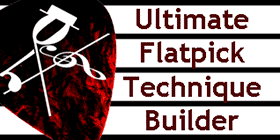This is a tune I call “Windin’ Up”. It was written with my flatpick students in mind as I was looking for something to help super-charge flatpick guitar technique.
Though the written part looks daunting, the piece is really VERY simple to play – and easy to memorize! …even for the “upper-fingerboard” challenged! Do NOT let the looks scare you off!
Things to look for:
A Fun Tune to Play
Driven by a constant 1 – 2 – 3 – 4 finger sequence on adjacent strings with strict alternate (down-up) picking pattern, you’ll find many of the technical flatpick challenges in a single, easy to remember – and fun to play tune!
Easily Memorized
The Simple pattern makes it possible to play a lot of quick, consecutive notes yet still be able to concentrate on other, finer aspects of the flatpick technique, like fluidity, speed, and tone!
Playing in a “Position”
This means our fingers are basically assigned to consecutive frets. Here (in 7th position), our 1st finger will play any note on any string that falls on the 7th fret. Then our 2nd finger will play 8th fret – 3rd finger, the 9th and finally, any note on the 10th fret, will be played with the 4th finger. There will be no barring though, each finger should work one-at-a-time. Since our frets are much closer together in 7th position than first position, this is a great place to start when first learning this tune! To create more challenge, try moving the entire exercise down to a lower position – say, 5th position. The song will be the same song only in a lower key and the frets will be slightly farther apart. Note; the play along tracks are for the key of C only – so contact me for other keys.
Strict Alternating Picking on Five Strings
Playing the little strings is very different than playing the big ones, and being able to move fluidly from one to another is a essential skill. Once we realize our picking hand’s sweet spot ( a bit subjective, is the most comfortable placement of our arm, wrist, fingers and pick as we hit a string) we should strive to hit each string using the same sweet spot. To do this we use our forearm as a “crane” to position our picking hand consistently over each string so we can stay in that sweet spot. This piece is a work out for each hand – independently AND together!
Keeping our Flatpick “Motor” Idling
The most common stumbling block amongst flatpick and mandolin students… learning to keep your picking hand idling while waiting to pick the next note. With hammer-ons, slides, pull offs, etc… the note is being “attacked” (struck / initiated) with the fingering hand. When this happens, the picking hand must not stumble or lose its groove. With eighth notes, we go down on the quarter note and up on the eighth, when reading sixteenth notes, we and will be going down on the eighth and up on the sixteenth. E.G. in measure two the pick direction would be … |D U D U D D U | Then there’d be a few beats with no notes being played. Our right hand should keep idling or “pulsing” to not lose the feel – also to not lose our place when we come back in.
Practice Dynamics Using the “Pinch and Release” Method
Pinch (to accent) each “first of four beats. In this piece, our little (4) finger plays on the 10th fret and that is the “first of four” then we immediately release the pick grip in order to allow the other notes to be played quieter – creating more interest. With a loose pick grip as our default, we could also think of it as relaxing the pick grip on ALL notes then firming up our grip just on the “first of four” to give the emphasis.
As Easy as 1 – 2 – 3 – (4) over & over & over & over etc…
The simplest way to view this tune is to first play the D string – 10th fret (4th finger)
Then… (Starting on the A string) we use fingers: 1 -2 -3 and 4 – on frets 7- 8-9 and 10.
We then move to the D string and repeat our pattern (fingers 1 -2 -3 -4 on frets: 7-8-9-10).
Then to the G string and so on. This pattern makes only a couple small changes off this basic idea. I believe you will be able to hear what’s going on by playing the first example “ULTIMATE FTB 50 BPM”
Play along with the Backups
ULTIMATE FTB 50 BPM
ULTIMATE FTB 60 BPM
ULTIMATE FTB 70 BPM
ULTIMATE FTB 80 BPM
ULTIMATE FTB 90 BPM
ULTIMATE FTB 100 BPM
ULTIMATE FTB 110 BPM
ULTIMATE FTB 120 BPM
ULTIMATE FTB 130 BPM
ULTIMATE FTB 140 BPM
Swing
ULTIMATE FTB 120 BPM SW
ULTIMATE FTB 140 BPM SW
ULTIMATE FTB 160 BPM SW
ULTIMATE FTB 175 BPM SW
ULTIMATE FTB 190 BPM SW







